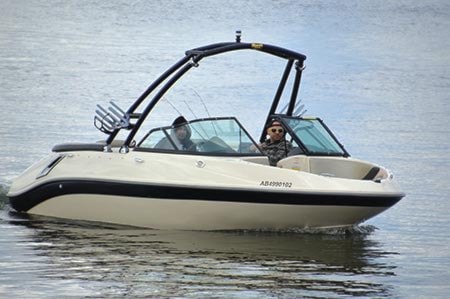Submitted by PLRL
While Alberta Health Services reports there are already 21 Alberta lakes with shore sludge and blue-green algae blooms, Pigeon Lake is boasting clean beaches and unspoiled water. Remembering last year’s unprecedented algae blooms, Ian Rawlinson, chair of community action group the PLRL, admits the situation is not “readily explainable.”
Nature clearly is contributing, he admits, “perhaps through cloudy skies and winds, but that’s not the complete answer because heavy rains carry pollutants into the lake and warm water (now near 20 degrees C for weeks) would normally contribute to blooms.” Rawlinson is convinced that citizen initiatives like the cleaning of shorelines, diverting runoff, avoiding fertilizers and installing a public sewer system are making a difference. He also reported possible future aids through current research regarding natures “algae food chain consumption the mechanical skimming of blooms and the use of iron or the natural Australian compound “Phoslock.”
“We are absolutely entering a new era of hope,” suggested Rawlinson, the water is clear, sandy beaches are pristine, lake crowds are increasing, properties are selling, the fishing is great and revitalized provincial parks are now among the best in the province.” “We will enjoy these great conditions now,” the PLRG chairman added “as we continue to work with nature, the government and the citizens until water clarity is a permanent condition.”
Crystal Clear Waters
Ian Rawlinson chairs a citizen’s “league” formed in August of last year to “pursue aggressive remediation solutions for a distressed lake.” Since that time they “have pushed and partnered with governments and citizens alike and initiated or promoted a number of possible contributors to the current clear water at Pigeon Lake”
The PLRL stated 57 per cent of the algae production comes from the lakebed itself and for the first time, winter accumulations on the shores were cleaned through organized resident initiatives. One south shore community alone, picked, loaded and hauled away 120 cubic yards of “algae mats,” 12 single axel dump trucks.
They stated 27 per cent of the lakes pollution comes from water runoff and the Pigeon Lake Watershed Association (PLWA) has a creative new program teaching residents how to re-direct runoff to rain gardens and barrels and in other ways trap polluting waters.
Through new laws and education, almost all residents have discontinued the use of phosphorous loaded fertilizers and some are avoiding lawns in favor of planting water-filtering florae.
South shore residents will soon have a public sewer system and the planning process and publicity has residents better educated about septic tanks and fields and the dumping of “grey water” and other pollutants.
Rawlinson’s group has spent the last 11 months both “advocating and educating” and they have actively promoted the above initiatives and six more in a ten strategy “Action Plan.” A brochure detailing how citizens can participate is available at mailboxes, in area stores and from the web at pigeonlakerenewal.weebly.com.
Among the Action Plans promising strategies are from a coalition, the Alliance of Pigeon Lake Municipalities (APLM) who are fostering two studies by the U of A, one that could lead to a “food chain balance” for better natural algae destruction, and one using iron products. There is also a very promising Australian compound Phoslock that inhibits algae production with recent good results at Henderson Lake near Lethbridge. Another possibility is the mechanical skimming of late summer algae blooms from the surface, with one resident offering to purchase an “algae harvester.”
